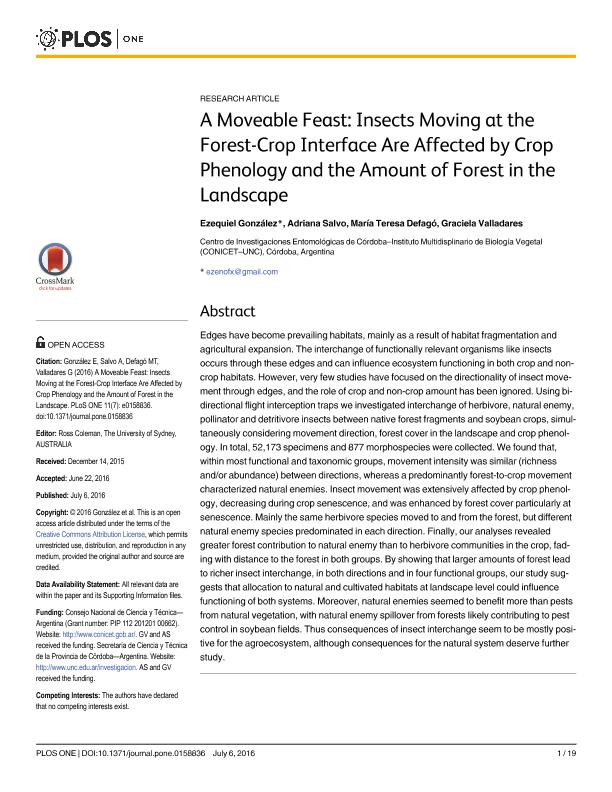Artículo
A moveable feast: insects moving at the forest-crop interface are affected by crop phenology and the amount of forest in the landscape
Fecha de publicación:
06/2016
Editorial:
Public Library Of Science
Revista:
Plos One
ISSN:
1932-6203
Idioma:
Inglés
Tipo de recurso:
Artículo publicado
Clasificación temática:
Resumen
Edges have become prevailing habitats, mainly as a result of habitat fragmentation and agricultural expansion. The interchange of functionally relevant organisms like insects occurs through these edges and can influence ecosystem functioning in both crop and non-crop habitats. However, very few studies have focused on the directionality of insect movement through edges,and the role of crop and non-crop amount has been ignored. Using bi-directional flight interception traps we investigated interchange of herbivore, natural enemy, pollinator and detritivore insects between native forest fragments and soybean crops, simultaneously considering movement direction, forest cover in the landscape and crop phenology. In total, 52,173 specimens and 877 morphospecies were collected. We found that, within most functional and taxonomic groups, movement intensity was similar (richness and/or abundance) between directions, whereas a predominantly forest-to- crop movement characterized natural enemies. Insect movement was extensively affected by crop phenology, decreasing during crop senescence, and was enhanced by forest cover particularly at senescence. Mainly the same herbivore species moved to and from the forest, but different natural enemy species predominated in each direction. Finally, our analyses revealed greater forest contribution to natural enemy than to herbivore communities in the crop, fading with distance to the forest in both groups. By showing that larger amounts of forest lead to richer insect interchange, in both directions and in four functional groups, our study suggests that allocation to natural and cultivated habitats at landscape level could influence functioning of both systems. Moreover, natural enemies seemedto benefit more than pests from natural vegetation, with natural enemy spillover from forests likely contributing to pest control in soybean fields. Thus consequences of insect interchange seem to be mostly positive for the agroecosystem, although consequences for the natural system deserve further study.
Archivos asociados
Licencia
Identificadores
Colecciones
Articulos(IMBIV)
Articulos de INST.MULTIDISCIPL.DE BIOLOGIA VEGETAL (P)
Articulos de INST.MULTIDISCIPL.DE BIOLOGIA VEGETAL (P)
Citación
González, Ezequiel; Salvo, Silvia Adriana; Defagó, María Teresa; Valladares, Graciela Rosa; A moveable feast: insects moving at the forest-crop interface are affected by crop phenology and the amount of forest in the landscape; Public Library Of Science; Plos One; 11; 7; 6-2016; 1-19; 0158836
Compartir
Altmétricas




